I can pinpoint the moment that I knew that the London Olympics were going to be great. James Bond was in Buckingham Palace meeting the Queen. It had to be a lookalike, didn’t it? Then she turned around and it really was the Queen.
On July 27th, 2012, 900 million people worldwide watched the Olympic Opening Ceremony. For the few preceding years, London Blue Badge Tourist Guides had been doing tours in East London, where the Olympic Park had risen from the polluted soil. Could a park really be created where old refrigerators were sent to die?
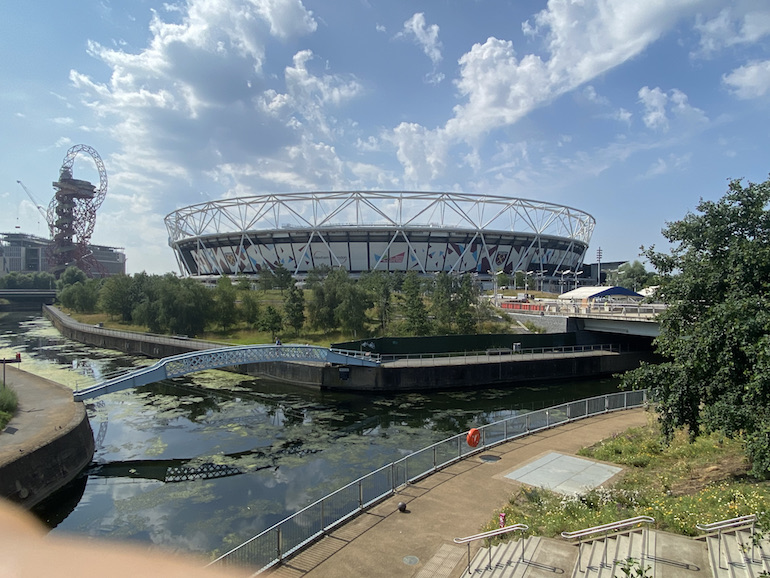 London Stadium along with orbit waterway at Queen Elizabeth Olympic Park. Photo Credit: © Sarah Wood.
London Stadium along with orbit waterway at Queen Elizabeth Olympic Park. Photo Credit: © Sarah Wood.
The idea of hosting the Olympics Games in East London was not new. In the 1980 film The Long Good Friday Bob Hoskins, standing in a derelict Canary Wharf told a potential Mafia investor ‘we could hold the 1988 Olympic Games here.’ (They went to Seoul.)
The River Lea was where industrial London began. Raw materials came from all over the world into the nearby London docks and were transported by train to factories all over the country. The rail lands in Stratford were where everything was made for the railways and the soil became so toxic that the land became unusable until the London 2012 Olympic Games arrived.
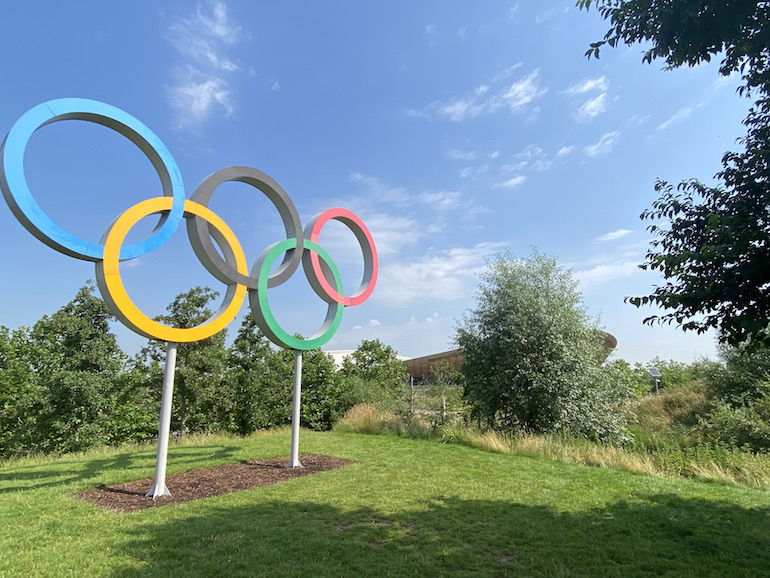 Olympic Rings with velodrome in distance at Queen Elizabeth Olympic Park. Photo Credit: © Sarah Wood.
Olympic Rings with velodrome in distance at Queen Elizabeth Olympic Park. Photo Credit: © Sarah Wood.
The industry here was at its smelliest. The Bow area of London was home to slaughterhouses; animal by-products were used to make bone china, soap, and glue. When the wind was in the wrong direction the smell was unbearable. There were gin distilleries, sugar refining bakeries, and Bryant and May match factory. Guides can learn so much from their clients. I will never forget one woman telling me of her great grandfather who had worked at Bryant and May and, like so many, died prematurely from ‘phossy jaw’, caused by yellow phosphorus in the matches. Being Irish Catholics they had a wake and his body glowed in the dark in his coffin.
At the London 2012 Olympic Games, it felt like the stars were in alignment. It was the Queen’s Golden Jubilee year and her granddaughter, Zara Philips won a silver medal in horse-riding at Greenwich, which had been made a Royal Borough that year. Bradley Wiggins became the first Briton to win the Tour de France and also won a gold medal for Team GB, presented to him in front of Hampton Court Palace. Local boy David Beckham, a crucial part of the original bid team, brought the Olympic torch along the Thames to the Olympic Stadium in the opening ceremony. (He went to the same school a few miles from the park as the present England soccer captain Harry Kane.) Andy Murray won at Wimbledon that year as well as a gold medal in the men’s tennis, which was held there. The marathons finished in front of Buckingham Palace. Even beach volleyball had a historic setting on Horseguards Parade where Henry the Eighth had jousted.
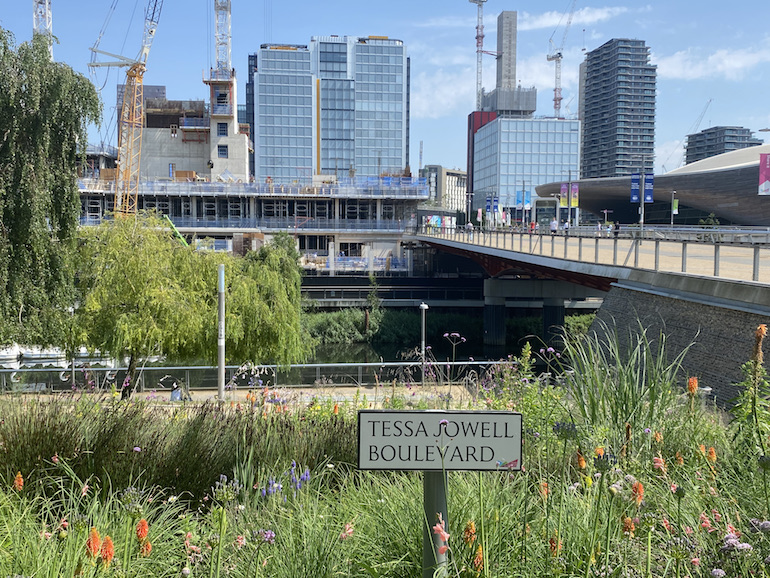 Tessa Jowell Boulevard at Queen Elizabeth Olympic Park. Photo Credit: © Sarah Woods.
Tessa Jowell Boulevard at Queen Elizabeth Olympic Park. Photo Credit: © Sarah Woods.
The Olympic Park (now renamed Queen Elizabeth Olympic Park) also hosted the most successful Paralympic Games in history with a string of firsts: the first where every event was televised, the first to be sold out, the first in a completely accessible park. At the last Olympic Games to be held in London in 1948 Dr. Ludwig Guttmann, a German Jewish refugee, encouraged disabled World War Two veterans to take part in sport. Out of this, the Paralympics was born.
The reason Britain won the bid in 2005 was not only for a few weeks of sport but the promise of the long-term transformation that the London 2012 Olympic Games could offer East London, one of the most deprived parts of the country. We were promised a legacy that no previous Olympics had achieved. So what does Queen Elizabeth Olympic Park have to offer today and has that promise been fulfilled?
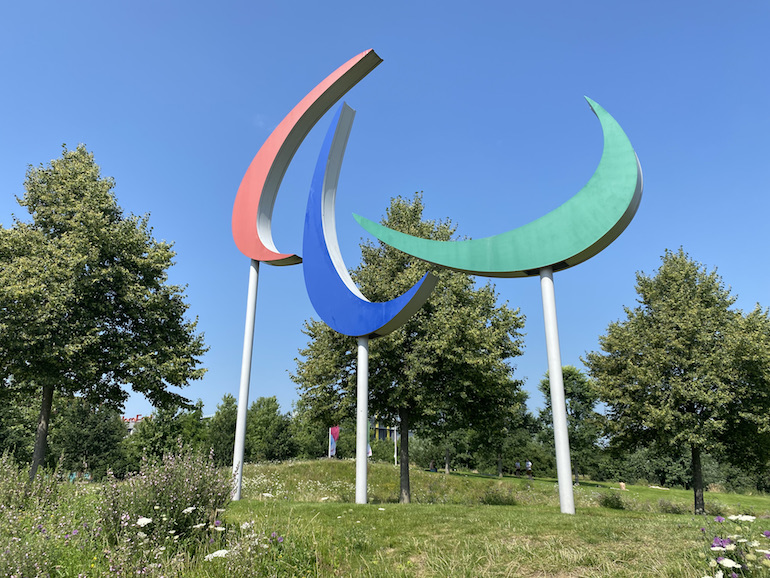 Agitos Paralympic symbol at Queen Elizabeth Olympic Park in London. Photo Credit: © Sarah Wood.
Agitos Paralympic symbol at Queen Elizabeth Olympic Park in London. Photo Credit: © Sarah Wood.
Queen Elizabeth Olympic Park
The greatest legacy of the London 2012 Olympic Games is Queen Elizabeth Olympic Park itself. It is the largest new park created in Europe in over 150 years and the best landscape and planting designers were involved from the beginning.
Sustainability was at the core of our Olympic promise. When Britain won the bid in 2005 one of the first things to be done was to wash the soil to rid it of pollutants. The River Lea was cleaned and a new lock was built close to the Park to prevent the flooding to which this area had been vulnerable. Landscape designer Noel Kingsbury said:
‘We found the character for the Olympic Park and made it meaningful through rescuing the River Lea from the bottom of a deep polluted channel. We pulled back its banks to make it more visible and accessible and increased the amount of green space in the Park. It works as an environmental system: reusing and recycling material from previous land uses; creating generous and diverse habitats; saving 4,500 homes nearby from flood risk, and incorporating renewable energy.’
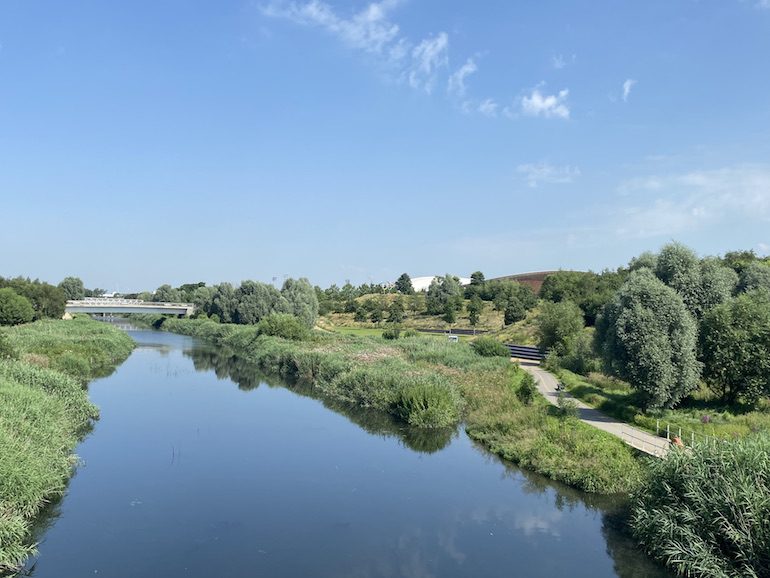 River Lea velodrome in distance at Queen Elizabeth Olympic Park. Photo Credit: © Sarah Wood.
River Lea velodrome in distance at Queen Elizabeth Olympic Park. Photo Credit: © Sarah Wood.
Queen Elizabeth Olympic Park is a modern park using naturalistic planting with wildflowers and grasses rather than formal beddings. This is a space that invites us all to come and play. There are no signs telling people how to behave and few fences, not even around the park, which is open twenty-four hours a day.
The park is separated into north and south, the north springing from the old industrialised waterway and south recreating a series of eight ‘outdoor rooms’, twenty-first-century pleasure gardens, each with its own distinctive feel. Throughout the park are further innovative and distinctive areas:
- The native wildflower meadows to the south of the park create a new style of planting blending flowering perennials and grasses.
- The 2012 gardens are a celebration of four biodiverse plant habitats where ‘plant communities’ rather than a series of individual and segregated plants.
- The Waterglades, a wetlands walk, is one of my favourite areas where a large wetland bowl has been created out of the river path allowing the harvested water to be cleaned, treated, and reused. It has an extraordinary diversity of wildlife – dragonflies, water voles, herons, goldfinches, and ducks.
- Eight outdoor rooms near the London Stadium include a wonderful and well-used water labyrinth, stadium-style wooden steps, and inventive children’s play areas.
- The Great British Garden, in the shadow of the Stadium, was designed by two amateur gardeners, winners of a Royal Horticultural Society competition with a bronze, silver, and gold planting scheme.
- A new addition in 2021 is the Blossom Garden, with thirty-three trees representing each of the London boroughs. It is planted with cherry, cherry plum, crab apple, and hawthorn trees that will blossom in the Spring. This is London’s memorial garden to the victims of the Covid pandemic.
- The Tumbling Bay has a gradually graded series of naturalistic children’s play areas, stunningly and imaginatively designed.
- Climbing walls are just some of the outdoor facilities available to anyone.
- The Olympic Bell, struck by cyclist Bradley Wiggins to mark the beginning of the 2012 Opening Ceremony now has a permanent home on the park. It was forged at the nearby Whitechapel Bell Foundry where Big Ben and the Liberty Bell were also cast.
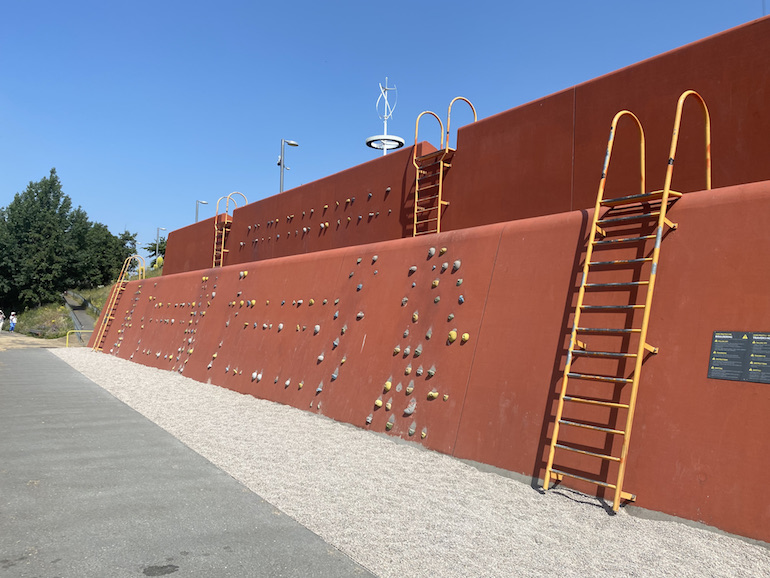 Climbing Wall at Queen Elizabeth Olympic Park. Photo Credit: © Sarah Wood.
Climbing Wall at Queen Elizabeth Olympic Park. Photo Credit: © Sarah Wood.
The permanent venues on the park are much in use for elite and grassroots sport. The connectivity of Stratford makes Queen Elizabeth Olympic Park one of the best-connected public transport hubs in the capital. During the Games, every visitor was given a one-day travel card along with their ticket, all travel by public transport.
Zaha Hadid’s Aquatic Centre is one of the stars of the park. This is the pool where Michael Phelps became the most decorated Olympian of all time. Its three pools have some of the best community swimming facilities in the country at the same price as leisure centre pools. Sessions are held for all levels from beginners to swimmers at the competition level. You can learn to dive in the same pool where Tom Daley trains and in term time the pools are used by local schools.
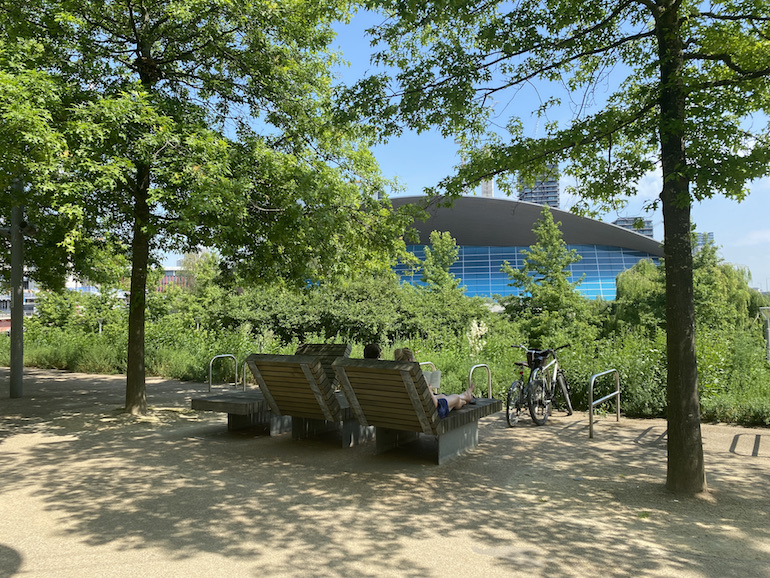 Chilling by the London Aquatic Centre at Queen Elizabeth Olympic Park. Photo Credit: © Sarah Wood.
Chilling by the London Aquatic Centre at Queen Elizabeth Olympic Park. Photo Credit: © Sarah Wood.
The Velodrome and the Velopark. The velodrome is such an elegant building. Designed by Michael Hopkins, the double curve of the roof mirrors the bulge and drop of the racetrack. It has natural light and ventilation and, in keeping with the sustainability strategy of the rest of the park, rainwater is harvested from the roof. All skill levels from beginners to elite cyclists can book to use the Velodrome track, the BMX and the cycling track. You can have a coffee in the 42 degrees café and watch the track in use. Take a look at the 2012 medals tables by the lifts and you’ll see that cycling was one of the great successes of the Games and started a cycling revolution in London.
The Copper Box was built for Olympic handball and many Paralympics sports in 2012 as well as the first Invictus Games in 2014. This most versatile venue is now a gym and fitness centre, home to the London Lions basketball team, the London Titans wheelchair basketball team, and local netball, handball, and futsal teams. It is also used by twenty local sports clubs, twenty local schools, and many local community groups.
The Lea Valley Hockey and Tennis Centre, north of the park at Eton Manor, offers sessions for all levels.
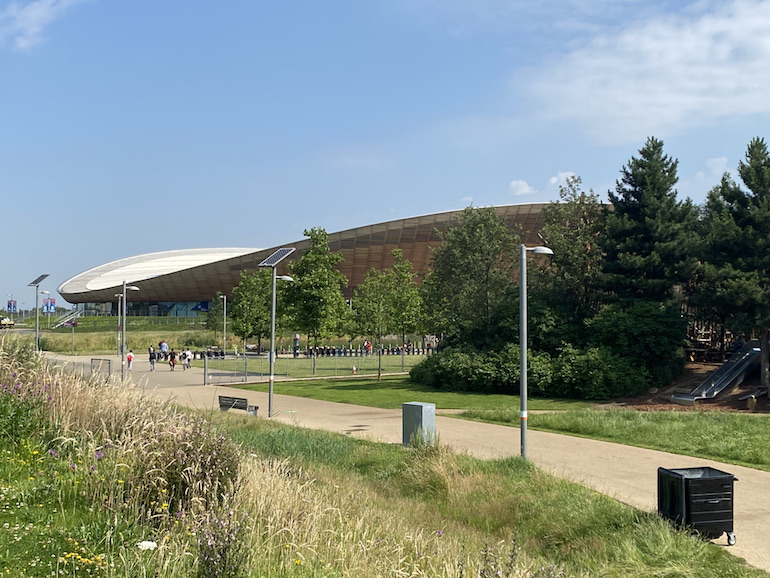 Velodrome roof at Queen Elizabeth Olympic Park in London. Photo Credit: © Sarah Wood.
Velodrome roof at Queen Elizabeth Olympic Park in London. Photo Credit: © Sarah Wood.
The London Stadium was the site of Danny Boyle’s incredible creative tour de force, the London 2012 Opening Ceremony, which can be seen on YouTube in all its inventive and eccentric glory. Today, it is home to West Ham United, the ‘Hammers’, named in reference to their origin as the team of the Thames Ironworks.
Future Projects at Queen Elizabeth Olympic Park
2022 will see the opening of the first phase of East Bank, a cultural and educational collaboration between the BBC, University College London, the Victoria & Albert Museum, UAL’s London College of Fashion, and Sadlers’ Wells. Construction is underway and this project will add to the many big names that have already moved to the park.
Visit Queen Elizabeth Olympic Park
Queen Elizabeth Olympic Park is a real success story of urban regeneration, using an international sporting event as a catalyst for lasting and thoughtful change bringing huge benefit to the local community. A visit to the park works on so many levels. Why not have a London Blue Badge Tourist Guide show you around this inspiring, exhilarating, and beautiful park?
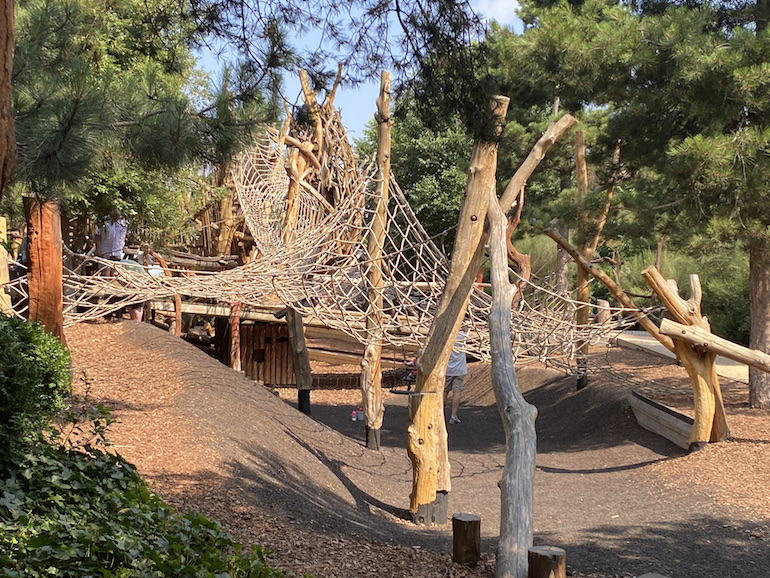 Tumbling Bay in the playground at Queen Elizabeth Olympic Park in London. Photo Credit: © Sarah Wood.
Tumbling Bay in the playground at Queen Elizabeth Olympic Park in London. Photo Credit: © Sarah Wood.
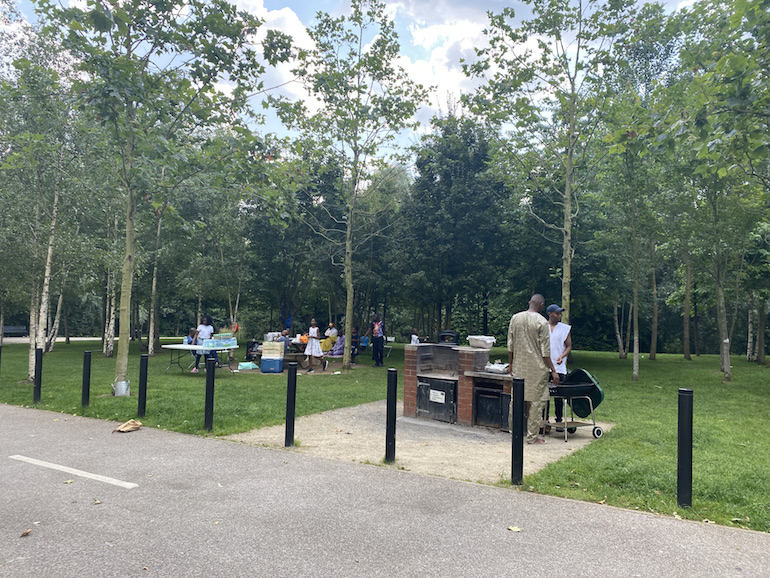 BBQ area at Queen Elizabeth Olympic Park in London. Photo Credit: © Sarah Wood.
BBQ area at Queen Elizabeth Olympic Park in London. Photo Credit: © Sarah Wood.
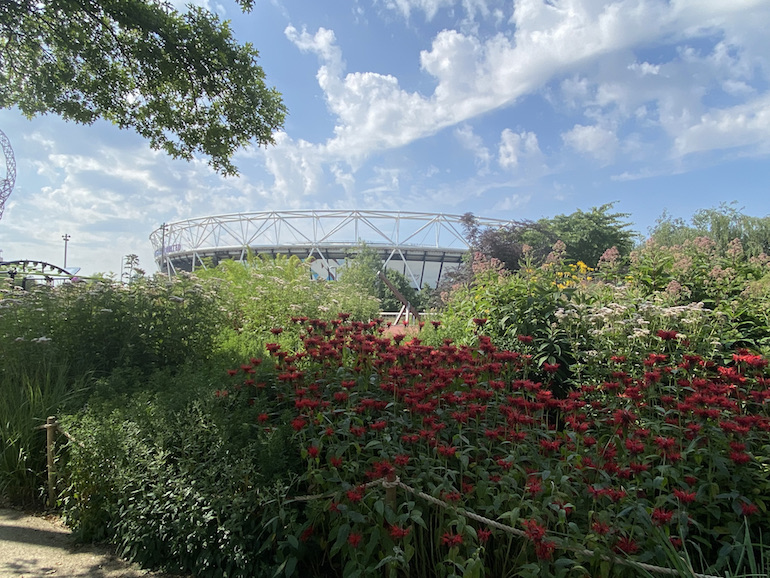 Wildflowers near London Stadium at Queen Elizabeth Olympic Park. Photo Credit: © Sarah Wood.
Wildflowers near London Stadium at Queen Elizabeth Olympic Park. Photo Credit: © Sarah Wood.
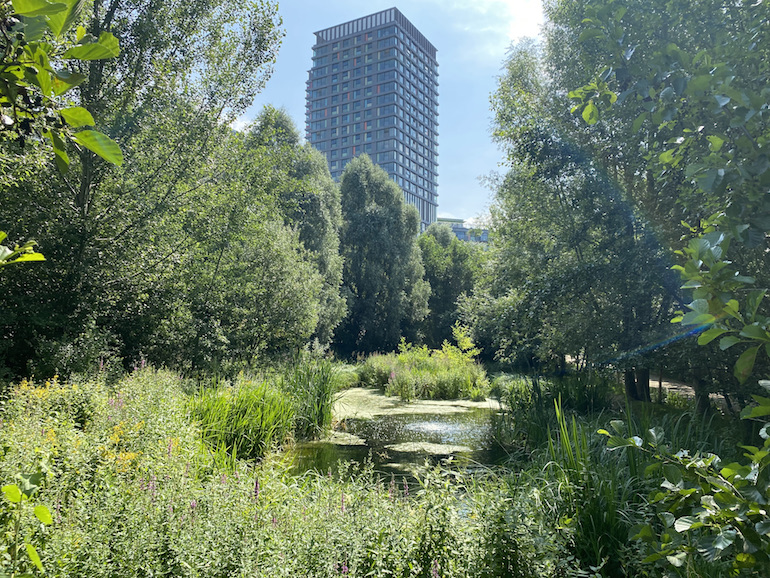 Waterglades at Queen Elizabeth Olympic Park in London. Photo Credit: © Sarah Wood.
Waterglades at Queen Elizabeth Olympic Park in London. Photo Credit: © Sarah Wood.



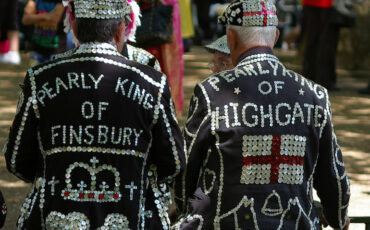
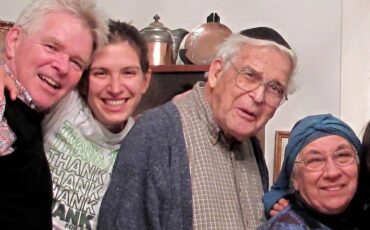


Leave a Reply